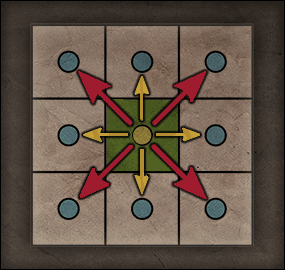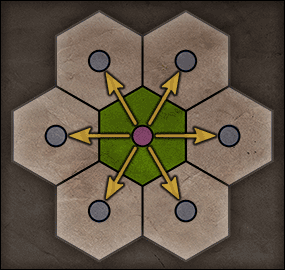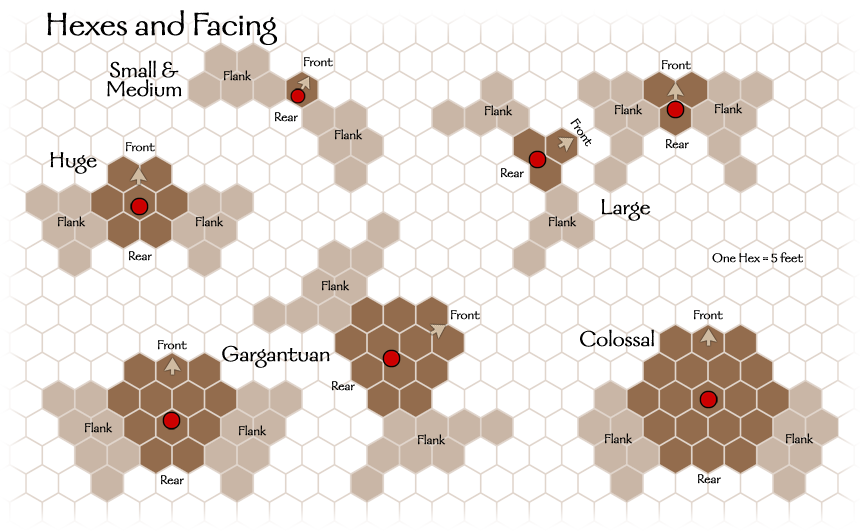You are using an out of date browser. It may not display this or other websites correctly.
You should upgrade or use an alternative browser.
You should upgrade or use an alternative browser.
Combat Spaces: Squares, Hexes, or Zones?
- Thread starter Aldarc
- Start date
Overall squares work best with most games IMHO. The only real drawback is diagonal movement - you either need to do the moderately fiddley 1.5 move (Pathfinder) or just ignore geometry and treat movement in any direction the same (5E). Neither approach is ideal, but both work fine.
Hexes handle diagonal movement better but don't work well with the right angles that are common in dungeons and building interiors. Its easy to lay a grid over most dungeon maps, but with a hex overlay you get a lot of half spaces. For a game that is mostly about fighting in open spaces (e.g. Battletech) hexes are the way to go, but for a D&D/Pathfinder type game squares work better.
Zones are fine if you don't have or want maps, but you obviously only get the most basic details. I tend to play on a VTT where maps are easy, and I can't see a situation where I would use zones over a grid/hex map.
Hexes handle diagonal movement better but don't work well with the right angles that are common in dungeons and building interiors. Its easy to lay a grid over most dungeon maps, but with a hex overlay you get a lot of half spaces. For a game that is mostly about fighting in open spaces (e.g. Battletech) hexes are the way to go, but for a D&D/Pathfinder type game squares work better.
Zones are fine if you don't have or want maps, but you obviously only get the most basic details. I tend to play on a VTT where maps are easy, and I can't see a situation where I would use zones over a grid/hex map.
Thomas Shey
Legend
All of the above.
I'm mostly here, though I don't think zones work all that well for anything with any real detail.
There are issues that can come up with both hexes and squares; sometimes I wish staggered squares had caught on more than they did.
Thomas Shey
Legend
Overall squares work best with most games IMHO. The only real drawback is diagonal movement - you either need to do the moderately fiddley 1.5 move (Pathfinder) or just ignore geometry and treat movement in any direction the same (5E). Neither approach is ideal, but both work fine.
Hexes handle diagonal movement better but don't work well with the right angles that are common in dungeons and building interiors. Its easy to lay a grid over most dungeon maps, but with a hex overlay you get a lot of half spaces. For a game that is mostly about fighting in open spaces (e.g. Battletech) hexes are the way to go, but for a D&D/Pathfinder type game squares work better.
Zones are fine if you don't have or want maps, but you obviously only get the most basic details. I tend to play on a VTT where maps are easy, and I can't see a situation where I would use zones over a grid/hex map.
Hexes tend to work a little better with outside terrain in a lot of cases too, IMO, and are bit better at handling facing issues. You're dead right about the problems with buildings and other situations with right angles though; in particular you can get some artifacts with hallways and such (an infamous one we saw years ago what going around two sides of a square in a building where, because of the hex grid, one side was longer than the other even though they were avowedly the same and appeared so visually).
payn
Glory to Marik
Right tool for the right job. I like zones for ToTM, squares for indoors and dungeons, and hexes for outdoor and expansive spaces.I'm mostly here, though I don't think zones work all that well for anything with any real detail.
There are issues that can come up with both hexes and squares; sometimes I wish staggered squares had caught on more than they did.
Thomas Shey
Legend
Right tool for the right job. I like zones for ToTM, squares for indoors and dungeons, and hexes for outdoor and expansive spaces.
Definitely an argument; I don't do TotM for anything with any tactical detail because I can neither keep the spatial relationships in my head very well nor describe them particularly well, but as I've noted, other people obviously don't have my limitations here.
I usually find systems are really not set up to handle both hexes and squares well within the same system.
I prefer hexes, but games I play in seem to always be stuck on squares.
The idea that squares are better for buildings really only works if you're willing to suspend disbelief and think that right angles are some sort of naturally occurring phenomenon. If real simulation is the goal, you should have to regularly rotate the squares to account for angular shifts. And if you're going to be rotating the base grid, you can do so just as easily with hexes.
The idea that squares are better for buildings really only works if you're willing to suspend disbelief and think that right angles are some sort of naturally occurring phenomenon. If real simulation is the goal, you should have to regularly rotate the squares to account for angular shifts. And if you're going to be rotating the base grid, you can do so just as easily with hexes.
Similar Threads
- Replies
- 55
- Views
- 7K
- Replies
- 15
- Views
- 2K
- Replies
- 87
- Views
- 7K





